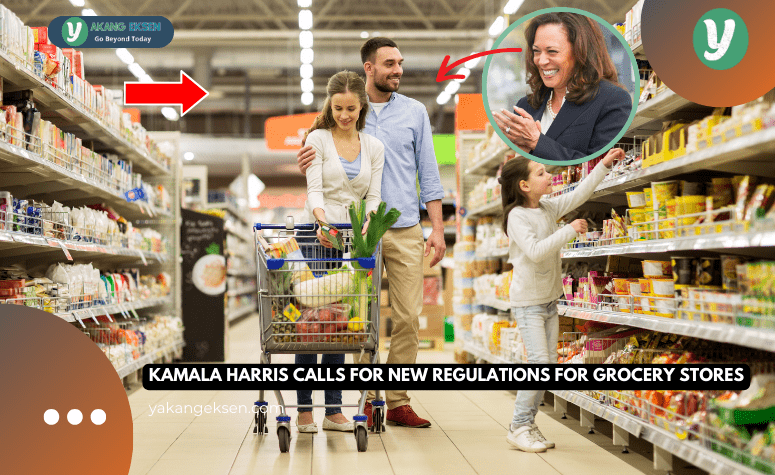Table of Contents
- 1 Kamala Harris Calls for New Regulations for Grocery Stores
- 1.1 In a Peaceful Garden, Surprising News Emerges
- 1.1.1 Harris’ Grand Plan to Control Food Prices
- 1.1.2 Skepticism and Hope Amid the Debate
- 1.1.3 Inflation Indicators and the Challenges Ahead
- 1.1.4 Waiting for the Outcome: What Will Happen Next?
- 1.1.5 What is Price Gouging? A Closer Look at Its Definition and Impact
- 1.1.6 Challenges in Enforcing Price Gouging Laws
- 1.1.7 Diverging Voices, From Price Gouging to “Shrinkflation”
- 1.1.8 Impact on the Food Industry, Mixed Reactions from Major Players
- 1.2 Seeking Solutions, What Steps Should Be Taken?
- 1.1 In a Peaceful Garden, Surprising News Emerges
Kamala Harris Calls for New Regulations for Grocery Stores
In a Peaceful Garden, Surprising News Emerges
yakangeksen.com, Kamala Harris Calls for New Regulations for Grocery Stores – This afternoon, amidst the blooming flowers in a peaceful garden, they opened their phones to check the latest news on social media. To their surprise, they read that Vice President Kamala Harris has called for new regulations that could change the landscape of grocery store businesses in the United States. A bold move that touches not only the economy but also everyday life.
Harris’ Grand Plan to Control Food Prices
Kamala Harris unveiled a new economic agenda focused on a federal ban on price gouging. This measure aims to stop grocery store chains, food suppliers, and other businesses from allegedly raising prices unfairly on consumers. Harris emphasized that while some major food companies have made record profits over the past two decades, not all of them have passed these savings on to consumers.
“Many businesses contribute to our economy by following the rules, but some do not, and that’s not fair,” Harris declared firmly in a speech in Raleigh, NC.
Skepticism and Hope Amid the Debate
However, this plan has not been without skepticism. Some, like Allison Schrager, a senior fellow at the Manhattan Institute, believe that the ban will only scare grocery chains without offering real solutions. They argue that this ban will not lower prices but might instead limit the availability of grocery stores in some needed areas.
On the other hand, consumer advocates see this regulation as a new beacon of hope. They urge for national protection against companies that use inflation as an excuse to increase profits. Liz Zelnick from Accountable.US pointed out that some companies have the ability to lower prices earlier and pass on savings to consumers but choose not to.

Inflation Indicators and the Challenges Ahead
With the consumer price index showing an annual inflation rate of 2.9% in July and food prices up 1.1% year-over-year, the pressure on living costs remains strong. Although inflation rates have declined, persistently high prices have made it difficult for many to meet daily needs. Harris has promised that this price gouging ban will penalize companies that exploit crises and break the rules.
Waiting for the Outcome: What Will Happen Next?
As they read this news in the quiet afternoon, surrounded by the scent of blooming flowers, they couldn’t help but feel both shocked and intrigued by Kamala Harris’s bold move. Will this new regulation bring about significant change or simply add more complexity to the economy? Only time will tell, but one thing is certain: this step has opened a new chapter in the national debate on food prices and economic justice.
What is Price Gouging? A Closer Look at Its Definition and Impact
Amid growing anxiety, they began to wonder, “What exactly is price gouging?” Nearly 40 states in the United States already have their own laws prohibiting this practice, yet no federal regulation exists. Kamala Harris, drawing from her experience as California’s Attorney General, is determined to change this situation.
In California, price gouging occurs when the prices of goods and services rise by more than 10% after a state of emergency is declared. This definition varies across states, with some focusing on unreasonable price increases on essential commodities during crises.
Challenges in Enforcing Price Gouging Laws
Although these laws seem straightforward, enforcement is not as easy as it appears. Those who delve into this issue understand that price gouging often has different definitions in the eyes of the law and the public. Some believe that when a company uses inflation as an excuse to raise prices, it can be considered price gouging. However, legally, that may not be the case.

Kamala Harris aims to implement a uniform standard nationwide, not just at the state level but also at the national level. This is expected to curb companies from taking advantage of crises to rake in huge profits by raising the prices of essential goods.
Diverging Voices, From Price Gouging to “Shrinkflation”
In the midst of this debate, terms like “greedflation”—a term used to describe companies raising prices to reap huge profits—have emerged as reflections of public concern. Some, like Liz Zelnick, believe that this reflects behavior that exceeds the normal bounds of business.
However, there are others who see the issue from a different perspective. Phil Lempert, founder and editor of SupermarketGuru.com, highlights how grocery businesses, which operate on low-profit margins, may not be entirely responsible for the price increases. Instead, he suggests focusing more on “opportunistic pricing” and the phenomenon of “shrinkflation,” where consumers pay the same or higher prices for smaller products.
Impact on the Food Industry, Mixed Reactions from Major Players
As Harris delivered her speech, her campaign team pointed to the meat processing industry as one of the areas where unfair pricing has occurred. However, reactions from this industry have been mixed. Julie Anna Potts, President and CEO of the Meat Institute, rejected these claims, arguing that meat prices are based on supply and demand, and are influenced by factors like avian flu outbreaks and cattle shortages.
Meanwhile, BLS data shows that the price of ground beef per pound has remained above $5 since mid-2023, and egg prices have slightly decreased after a spike due to avian flu. These conditions illustrate the complexity of food pricing in the United States, which is influenced not by a single factor but by a series of complex dynamics.

Seeking Solutions, What Steps Should Be Taken?
With all the information presented, those reading the news this afternoon feel the need to reflect more deeply. The regulatory changes proposed by Kamala Harris could be a turning point in the effort to balance power between big companies and consumers. However, the success or failure of this regulation will largely depend on how it is implemented on the ground.
As the afternoon slowly fades, and the garden flowers begin to lose their luster, they wonder: Will this change bring about good, or will it create even greater challenges? Only time can tell. But one thing is certain: the world of grocery stores in America may never be the same again after this. (ya)**










